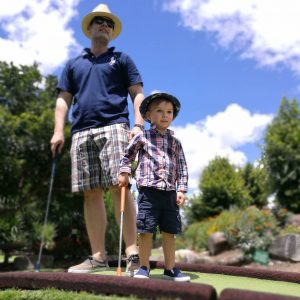Halloween! A Trick or Treat?
Trick or Treat – a trick or treat?
Just walk through the supermarkets or shopping centres any time after Father’s Day and you’ll be hard-pressed not to notice the growing prevalence of Halloween paraphernalia.
Growing up in Australia during the 1980s, children dressed as ghost and ghouls door knocking for sweets was a rarity and largely acknowledged as an American tradition. As a school-aged child I was bewitched by Disney’s “Night on Bald Mountain” (featured in the movie Fantasia) and was beguiled by the esoteric story of Ichabod Crane and Sleepy Hollow but the idea of going from house to house and asking strangers for lollies (and threatening them if they didn't hand them over) always left me with a sense of foreboding. School-drummed “stranger-danger” fuelled my imagination that rivalled any Hollywood horror story script and so my celebrations were limited to dressing up for a school dance, if that.
My initial instinct is to shy away from celebrating the holiday but it’s becoming increasingly difficult to ignore.
It’s obvious that over the years the mass commercialisation of the “hallowed” night has taken control with everyone from the major supermarkets to the local bank branch decorating their shop windows with cobwebs and pumpkins. I’m sure even parents of less observant toddlers wouldn’t be able to escape questions about what all the fuss is about. Mine is not only intrigued but enamoured by the spooktacular decorations. His curiosity is of course spurred by the themed episodes of Paw Patrol, Fireman Sam and Wallykazam just to name a few. Blippi at least is clever enough to include healthy messages discouraging children from eating “too much candy”.
I’m sure a recent family trip to Japan hasn’t helped my case with the locals celebrating Halloween arguably more intensely than the North Americans, with Zombies roaming the subways.

So rather than try and fight a losing battle, I’ve decided to embrace the occasion by concentrating on the culturally spiritual and scientific aspects rather than “confected” commercial elements. I also feel it's a great opportunity to let kids (big and small) get creative with their costumes, decorations and festive food, as well as get to know more of our neighbours and bring the community closer together.
What children can learn from Halloween:
-
ANTHROPOLOGY/ SOCIOLOGY: How and Why Other Cultures Celebrate Halloween.
Spain, Mexico and other Latin American countries commemorate the “Day of the Dead” - Día de los Muertos, which honours deceased loved ones and ancestors.
All Souls’ Day, which takes place on November 2, is commemorated with a three-day celebration that begins on the evening of October 31. The celebration is designed to honour the dead who, it is believed, return to their earthly homes on Halloween. The root word of Halloween - ''hallow'' - means ''holy.'' The suffix "een" is an abbreviation of "evening." It refers to the Eve of All Hallows, the night before the Christian holy day All Saints' Day on Nov. 1.
Many families construct an altar to the dead in their homes to honour deceased relatives and decorate it with flowers, photographs, fresh water and samples of the deceased’s favourite foods and drinks. Día de los Muertos festivities often feature breads, candies and other foods in the shape of skulls and skeletons.
Relatives also tidy the gravesites of their departed family members. This can include snipping weeds, making repairs, and painting. The grave is then decorated with flowers, wreaths, or paper streamers. On November 2, relatives gather at the gravesite to picnic and reminisce.
Such demonstrations of respect for passed family members may not be so prevalent in Australian society, but I think there’s a number of aspects to these practices that would benefit our community. Reflecting on these rituals can open discussions with young ones who may be inquisitive about life and death.
-
Phenology & Meteorology: The Changing of the Seasons
It is believed that Halloween traditions commenced from Celtic Harvest festivals of Samhain, an observance of the end of the harvest season that means summer's end. Samhain was also seen as a liminal time, when the boundary between this world and the “Otherworld” could more easily be crossed, and so ‘spirits’ needed to be propitiated with offerings of food and drink to ensure that the people and their livestock survived the winter.
Carving vegetables (originally turnips and potatoes) into jack-o’-lanterns is a popular Halloween tradition that originated in Ireland, hundreds of years ago. It wasn’t until Irish immigrants arrived in America and discovered the pumpkin that a new Halloween ritual was born.
Carving pumpkins is an opportunity to discuss how plants grow, and how these are influenced by seasonal and interannual variations in climate, as well as habitat factors and animal life cycle events.
Check out our post My First Calendar to learn more
-
GEOGRAPHY & ASTRONOMY: Northern v. Southern Hemispheres
The Gaelic festival marking the end of the harvest season and the beginning of winter or the "darker half" of the year is traditionally celebrated from 31 October to 1 November, this is about halfway between the autumn equinox and the winter solstice.
Whether you and your family reside in the Southern or Northern Hemispheres, it’s a good opportunity to explain the differences in the seasons and why these occur at different times of year for different countries.
Grab a globe and talk about your location on the planet compared to where other’s may be celebrating.
-
ANATOMY & BIOLOGY
Just like the KobraKai “ villains’ ” costumes in the original Karate Kid movie, the Skeleton Jumpsuit is a favourite amongst many trick or treaters. It’s a great chance to discuss how the human body is made up of bones, muscles and organs and to talk about their various functions, and interactions.
Make a game of it! Instead of pin the tail on the donkey, you can match the bones.
-
SCIENCE and SPIRITUALITY
For me, Halloween also presents itself as an opportunity to acknowledge that we don’t have all the answers. There’s just somethings in this world that even Google can’t explain and that we may never know. It’s an opportunity to stir your child’s curiosity, to encourage them to seek the truth, while appreciating traditions and other’s cultural practices.

How do you and your family celebrate Halloween?
Let us know in the comments or join us on our Facebook and Instagram pages.
You may also like
Victoria Park – Mini Golf & More
- November 21, 2017
- by Natalee-Jewel Kirby
- in Activities for Kids

Queensland Art Gallery – GOMA


